Electromagnetism facts for kids

Electromagnetism is a big part of physics. It helps us understand how electricity and magnetism are connected. It's all about the electromagnetic field. This field can push or pull anything that has an electric charge. It affects everything around us, even all of space!
Contents
What are Electric Fields?
An electric field is like an invisible area around a charged object. If another charged particle enters this area, it will feel a push or a pull. We measure the strength of electric fields in units called newtons per coulomb. Electricity and magnetism are very closely related because both involve the movement of tiny particles called electrons.
We can draw electric fields using arrows. These arrows show the direction a positive particle, like a proton, would move. Negative particles, like electrons, would move in the opposite direction. So, arrows point away from positive charges and towards negative charges. This means a proton would move away from another proton, but towards an electron.
A magnetic field is a special part of the electric field. It only creates a force on charges that are moving.
How Electricity and Magnetism Work Together
Imagine you have a changing magnetic field. This change can actually create an electric field! This amazing idea is called electromagnetic induction. It's how many important machines work. For example, electric generators make electricity this way. Induction motors and transformers also use this principle.
Because electric and magnetic fields are so connected, scientists realized they are two parts of one thing. They called this combined force the electromagnetic field.
The electromagnetic force is one of the main fundamental forces in nature. It's the force that makes electrons stick to the positive nucleus in an atom. In fact, all the forces between atoms happen because of the electromagnetic force.
What is Electromagnetic Radiation?
Electromagnetic radiation is a type of energy that travels through space. It's a bit mysterious because it acts like both a particle and a wave. Sometimes it behaves like a tiny particle, and other times it acts like a flowing wave. To make it easier, we can think of it as a stream of tiny energy packets called photons.
Tiny Packets of Light: Photons
A photon is a very small, basic particle. It's what light is made of! Photons also make up other types of electromagnetic radiation. These include gamma rays, X-rays, and UV rays. The idea of photons was first suggested by the famous scientist Albert Einstein. He explained that light comes in small "packets" or bundles, which he named photons.
Photons carry energy and momentum. When two electromagnetic fields interact, they exchange photons. This means photons are the ones that carry the electromagnetic force between charged objects. Think of photons as "messenger particles" in physics. They carry messages like "come closer" or "go away" between charged objects. If a force is happening over time, it means photons are being exchanged during that time.
Basic electromagnetic interactions happen between any two particles that have an electric charge. These interactions involve photons being exchanged or created. So, photons are the carriers of electromagnetic interactions.
Sometimes, a particle can break down in a process called decay. If this decay produces one or more photons (also known as gamma rays), it's often an electromagnetic decay. These decays happen slower than some other types of decay, but faster than others.
How We Learned About Electromagnetism
In 1600, a scientist named William Gilbert wrote a book called De Magnete. In it, he said that electricity and magnetism were two separate things. But later, a scientist named Hans Christian Ørsted found a link between them. He discovered that electric currents could create magnetic fields.
Then, a mathematician named André-Marie Ampère used math to describe electromagnetism. Many physicists then worked together to create a theory called classical electromagnetism. Finally, James Clerk Maxwell brought all these ideas together into one complete theory. This theory was based on Maxwell's equations and the Lorentz force law.
Maxwell's studies even showed what light truly was: an electromagnetic wave! However, Maxwell's work didn't quite fit with the older ideas of classical mechanics. This was because he said that the speed of light was always the same, no matter what. This surprising idea led to Albert Einstein's famous theory of special relativity.
New Ideas About Light
Even with Maxwell's amazing work, there were still some puzzles. Albert Einstein's work on the photoelectric effect and Max Planck's studies on black body radiation showed that light didn't always act like a smooth, continuous wave. This problem was finally solved when quantum mechanics was developed in 1925.
This new understanding led to a field called quantum electrodynamics. Scientists like Richard Feynman and Julian Schwinger helped create it. Quantum electrodynamics could describe how particles interact in amazing detail.
Images for kids
-
Aurora at Alaska showing light created by charged particles and magnetism, fundamental concepts to electromagnetism study
See also
 In Spanish: Electromagnetismo para niños
In Spanish: Electromagnetismo para niños






